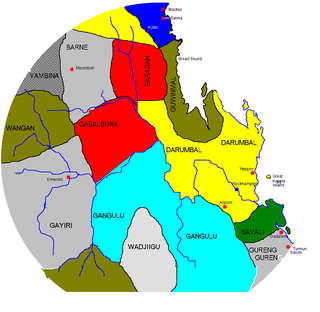The Goreng Goreng, also known Kooreng Gooreng, are an inland Freshwater Australian Aboriginal people of Queensland, and also a language group. The Goreng Goreng area is between Central West Queensland in the north around Boyne Valley, extending westerly as far as the Great Dividing Range along the Dawes, Auburn, Nogo and Callide Ranges to meet the Wulli Wulli and Ghunghulu to their immediate west over the Great Dividing Range.
The Badjiri people, also written Budjari or Badyidi, are an Australian Aboriginal people of just north of the Paroo River, close to the southern border of Queensland.
The Goeng or Gureng were an Aboriginal Australian people of the state of Queensland. They lived in the area of the area of present-day Gladstone.
The Gia people, also known as Giya, Kia, Bumbarra, and variants, are an Aboriginal Australian people of the state of Queensland. Little is known of them.
The Wakabunga are an indigenous Australian people of the state of Queensland.
The Bidjara people, also spelt Bitjara or Bithara, are an Aboriginal Australian people of south-western Queensland. They spoke a dialect of the Ngura language. They are not to be confused with the Warrego River Pitjara or the Badjiri of the Paroo River, both of whose traditional lands are further to the east of the state.
The Maikathari (Mayi-Thakurti) were an Aboriginal Australian people of the state of Queensland.
The Maijabi (Mayi-Yapi) were an indigenous Australian people of the state of Queensland.
The Miyan, or Mian, were an indigenous people of the state of Queensland.
The Ganulu, also spelt Kanolu, are an Aboriginal Australian people of the state of Queensland.
The Koa (Guwa) are Australian Aboriginal people and Native Title Holders of land in the Upper Diamantina River catchment area in the state of Queensland that includes the towns of Winton, Kynuna, Corfield and Middleton.
The Wanamara (Wunumara) were an indigenous Australian people of the state of Queensland.
The Pitapita or Pitta Pitta are an Aboriginal Australian people of the state of Queensland.
The Yagalingu are an Aboriginal Australian people of the state of Queensland. Their language may have been a dialect of Bidjara.

The Yambina were an Aboriginal Australian people of the state of Queensland, whose traditional lands lie inland (westwards) some distance from Mackay.
The Kunggara, also known as Kuritjara, are an indigenous Australian people of the southern Cape York Peninsula in Queensland.
The Mingin, also known as the Mingginda, are an Aboriginal Australian people of the state of Queensland, who lived in the Gulf Country east of Moonlight Creek and the Yukulta / Ganggalidda people in the southern Gulf of Carpentaria.
The Waluwara were an indigenous Australian people of the state of Queensland.
The Garaynbal, also written Karingbal, are an Aboriginal Australian people of the state of Queensland. They spoke a dialect of Biri called Garaynbal, now extinct.
The Gawambaraay (Kawambarai) are an Aboriginal Australian people of the state of New South Wales, closely connected to the Gamilaraay (Kamilaroi) people. Their traditional lands are in the central–western district of New South Wales